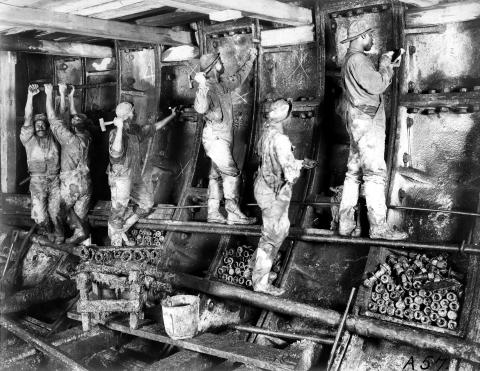
Today's #WorkerWednesday heads underground for a ca. 1909 photograph of railroad workers placing grommets under washers and tightening bolts as part of the construction of the Hudson River tunnel. The Pennsylvania Railroad began construction on this tunnel in 1904 so as to allow its trains to reach Manhattan. Train service began through the tunnel in late 1910.
This photograph is part of Hagley Library's collection of Pennsylvania Railroad photographs (Accession 1988.231). This collection of photographs primarily depict the Pennsylvania Railroad's facilities, rolling stock, and employees, but numerous views of similar facilities and equipment on other railroads, of nearby buildings and properties, or of standardized equipment and accessories that were collected for reference are also included.
The Pennsylvania Railroad (PRR) was chartered in 1846 to completing an all-rail road across the state. This was accomplished in 1854. In 1857, the PRR purchased the state's old "Main Line" of canals and railroads and brought the entire line from Philadelphia to Pittsburgh under one management complete a route from Harrisburg to Pittsburgh, thus opening up the entire state of Pennsylvania to east-west train service. This was accomplished in 1854.
In 1857 the Pennsylvania Railroad purchased the old Main Line system and eventually brought the entire line from Philadelphia to Pittsburgh under one management, becoming the largest railroad in the United States in terms of corporate assets and traffic from the last quarter of the nineteenth century until the decline of the northeast's and midwest's dominance of manufacturing.
Between 1855 and 1874, the PRR underwent rapid expansion and emerged as one of the two largest railroad systems in the area east of the Mississippi and north of the Ohio. Through stock purchase or lease, it reached Baltimore in 1861, Chicago and Indianapolis in 1869, St. Louis in 1870, Jersey City opposite New York in 1871, and Washington in 1872. Purchase of the Philadelphia, Wilmington & Baltimore Railroad in 1881 brought complete control of the important New York-Washington corridor, and in 1910, the PRR entered Manhattan through tunnels under the Hudson and East Rivers. Most of the main lines lying east and south of Harrisburg, Pennsylvania, were electrified between 1915 and 1938.
More than other railroads, the PRR was highly dependent upon the coal and steel industries and was burdened on its eastern end with a high-density passenger service. After 1958, the former began an irreversible decline, and the latter became a source of red ink.
The PRR merged with its major rival, the New York Central, in 1968 to create the Penn Central Transportation Company. The merger was ill-planned, bankruptcy in 1970. In 1971, the federal government created Amtrak to assume the most essential passenger service, and in 1976, viable portions of Penn Central and other bankrupt railroads in its territory were conveyed to Conrail, which rehabilitated them with federal funds.

